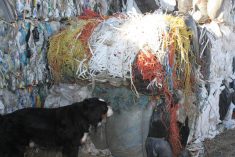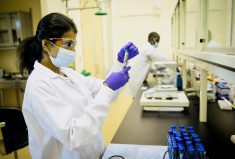Microplastic pollution is a global environmental problem that is ubiquitous in all environments, including air, water and soil.
Microplastics are readily found in treated wastewater sludge, also known as municipal biosolids, that eventually make their way to our agricultural soils.
Our recent investigation of microplastic levels in Canadian municipal biosolids found that a single gram of biosolids contains hundreds of microplastic particles. This is a much greater concentration of microplastics than is typically found in air, water or soil.
Given that hundreds of thousands of tonnes of biosolids are produced every year in Canada, we need to pay close attention to the potential impacts such high levels of microplastics might have on the environment and find ways to reduce microplastic levels in Canada’s wastewater stream.
Read Also

Guarding against misinformation: Do you believe in house hippos?
Misinformation and disinformation run rampant in today’s digital age. Farmers must be wary of the digital dangers and know how to keep themselves safe.
Municipal biosolids are produced at wastewater treatment plants by settling and stabilizing the solid fraction of the municipal wastewater inflow.
In Canada and around the world, municipal biosolids are used to improve agricultural farmland because they are rich in nutrients such as phosphorus and nitrogen.
Municipal biosolid applications are carefully regulated in Canada for heavy metals, nutrients and pathogens. However, guidelines for emerging contaminants, such as microplastics, are not currently available.
While wastewater treatment plants are not explicitly designed to remove microplastics, they are efficient at removing nearly 90 per cent of microplastic contaminants. The removed microplastics are often concentrated in the settled sludge and eventually end up in the biosolids.
Previous studies have shown that municipal biosolid waste is an important pathway for microplastics to enter broader terrestrial ecosystems, including agricultural fields.
In collaboration with scientists from Environment and Climate Change Canada and Agriculture and Agri-Food Canada, we conducted the first pan-Canadian assessment of microplastics in municipal biosolids. We analyzed biosolid samples from 22 Canadian wastewater treatment plants across nine provinces and two biosolid-based fertilizer products.
We found hundreds of microplastic particles in every gram of biosolids. The most common type of microplastic particles we observed were microfibres, followed by small fragments. We found small amounts of glitter and foam pieces too.
Microplastic concentrations in municipal biosolids are substantially higher than other environmental networks in Canada like water, soil and river sediments. This provides further evidence that microplastics are concentrated in biosolids produced at wastewater treatment plants.
Wastewater treatment plants are well-equipped to remove large plastics like bottle caps and plastic bags from municipal wastewater. However, microplastic particles are so small they can’t be caught by treatment infrastructure, so they concentrate in wastewater sludge.
As wastewater streams concentrate microplastics, they also offer an opportunity to reduce the plastic pollution that is entering the environment. Researchers across Canada are working to find insights on the short- and long-term ecological consequences of microplastic pollution on soil ecosystems and one solution is already clear.
Microplastics can be reduced at sources via systematic reduction in single-use plastics, washing clothing with synthetic fibre less frequently and removing microfibres using washing machine filters. These approaches will help minimize the amount of microplastics that get into the wastewater stream and, ultimately, into the broader terrestrial and aquatic environments.
Building new technologies at our wastewater treatment plants to remove microplastics through physical or chemical means should also be explored.
We need to better understand the impact of high concentrations of microplastic on agro-ecosystems where biosolids are applied, including its impacts on soil-dwelling organisms like earthworms and insects. We also need to start building national guidelines for microplastic levels in biosolids and agricultural soils.
— Branaavan Sivarajah a a postdoctoral fellow, Department of Geography and Environmental Studies, Carleton University; Jesse Vermaire is associate professor, Institute of Environmental Science, Carleton University.















